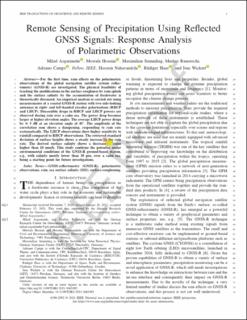| dc.contributor.author | Asgarimehr, Milad | |
| dc.contributor.author | Hoseini, Mostafa | |
| dc.contributor.author | Semmling, Maximilian | |
| dc.contributor.author | Ramatschi, Markus | |
| dc.contributor.author | Camps, Adriano | |
| dc.contributor.author | Nahavandchi, Hossein | |
| dc.contributor.author | Haas, Rüdiger | |
| dc.contributor.author | Wickert, Jens | |
| dc.date.accessioned | 2022-04-01T11:42:40Z | |
| dc.date.available | 2022-04-01T11:42:40Z | |
| dc.date.created | 2021-06-12T16:22:51Z | |
| dc.date.issued | 2021 | |
| dc.identifier.citation | IEEE Transactions on Geoscience and Remote Sensing. 2021, 60 . | en_US |
| dc.identifier.issn | 0196-2892 | |
| dc.identifier.uri | https://hdl.handle.net/11250/2989274 | |
| dc.description.abstract | For the first time, rain effects on the polarimetric observations of the global navigation satellite system reflectometry (GNSS-R) are investigated. The physical feasibility of tracking the modifications in the surface roughness by rain splash and the surface salinity by the accumulation of freshwater is theoretically discussed. An empirical analysis is carried out using measurements of a coastal GNSS-R station with two side-looking antennas in right- and left-handed circular polarizations (RHCP and LHCP). Discernible drops in RHCP and LHCP powers are observed during rain over a calm sea. The power drop becomes larger at higher elevation angles. The average LHCP power drops by ≈ 5 dB at an elevation angle of 45°. The amplitude of the correlation sum shows a dampening, responding to rain rate systematically. The LHCP observations show higher sensitivity to rainfall compared to RHCP observations. The retrieved standard deviation of surface heights shows a steady increase with the rain rate. The derived surface salinity shows a decrease at rains higher than 10 mm/h. This study confirms the potential under environmental conditions of the GNSS-R ground-based station, e.g., with salinity mostly lower than 30 psu, over a calm sea, being a starting point for future investigations. | en_US |
| dc.language.iso | eng | en_US |
| dc.publisher | IEEE | en_US |
| dc.subject | GNSS | en_US |
| dc.subject | GNSS | en_US |
| dc.subject | Remote Sensing | en_US |
| dc.subject | Fjernmåling | en_US |
| dc.title | Remote Sensing of Precipitation Using Reflected GNSS Signals: Response Analysis of Polarimetric Observations | en_US |
| dc.type | Journal article | en_US |
| dc.type | Peer reviewed | en_US |
| dc.description.version | acceptedVersion | en_US |
| dc.rights.holder | © 2021 EEE. Personal use of this material is permitted. Permission from IEEE must be obtained for all other uses, in any current or future media, including reprinting/republishing this material for advertising or promotional purposes, creating new collective works, for resale or redistribution to servers or lists, or reuse of any copyrighted component of this work in other works. | en_US |
| dc.source.pagenumber | 12 | en_US |
| dc.source.volume | 60 | en_US |
| dc.source.journal | IEEE Transactions on Geoscience and Remote Sensing | en_US |
| dc.identifier.doi | 10.1109/TGRS.2021.3062492 | |
| dc.identifier.cristin | 1915414 | |
| cristin.ispublished | true | |
| cristin.fulltext | postprint | |
| cristin.qualitycode | 2 | |
